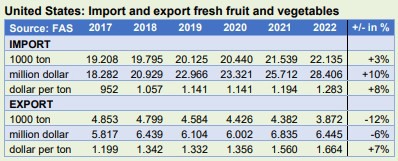Last year, the United States again imported more fruit and vegetables. At 22.1 million tons, that is three percent more than in 2021. Imports increased gradually in the previous years too. The U.S. is far from European farms, so import prices of fresh fruits and vegetables rose sharply by eight percent. That brings 2022's import value to over $28 billion, making the United States, by far, the top global importer. Germany is second with a value half that of the U.S.
The United States is slowly exporting less fruit and vegetables. In 2022, that fell by more than ten percent to 3.9 million tons. More than half go to Canada, and Mexico is a large buyer too. Last year, exports to the Netherlands fell sharply by ten percent to 86,000 tons. Most of this was sweet potatoes.

More than half from Mexico
Just over half of the U.S.'s imports come from Mexico. Last year, it was 11.4 million tons, two percent more than in 2021. In previous years, imports of Mexican products increased slightly faster than average.
Bananas are generally the most important import product. However, from Mexico, that is tomatoes, bell peppers, avocadoes, cucumbers, lemons, and watermelons. In 2022, the United States imported especially more tomatoes. At 1.8 million tons, a record amount. Mexican avocado imports (-13%) dropped remarkably. Besides tomatoes, in 2022, the U.S. also imported a record volume of Mexican cucumbers.
Bananas, an important product
Trailing far behind Mexico, Guatemala supplies the second most fresh fruit and vegetables to the U.S. In 2022, they sent 2.75 million tons. That was a record amount, though, and almost three-quarters were bananas.
Costa Rica came in at number three last year with 1.83 million tons. Imports from that country are inching down. About 60% was pineapple, with bananas as the other major product. Canada follows with a record 1.13 million tons in 2022. Cucumbers, tomatoes, and bell peppers are the United States' main Canadian import products.
Peruvian imports rise sharply
In fifth place: Peru. Last year, those imports topped the one million-ton mark for the first time. In 2017, that was still only 570,000 tons. Grape imports from Peru have risen particularly fast, from less than 100,000 tons in 2017 to 250,000 tons in 2022. Onions, blueberries, avocados, and Satsumas are the other significant products the U.S. imported from Peru.
The banana countries of Ecuador and Honduras follow, then Chile. Last year, Chilean imports dropped by eight percent to 760,000 tons; in 2018, that exceeded 900,000 tons. Chilean grape imports, however, increased sharply in 2022, up 17% to more than 300,000 tons. But, the sharp decline in Chilean orange, mandarin, and apple imports offset that. While the United States' imports of blueberries from Peru are growing rapidly, those imports from Chile have decreased in recent years.
Noticeably more imported from China, Morocco
With other suppliers, imports from China and Morocco increased noticeably. Those from China grew to 200,000 tons and from Morocco to 125,000 tons. China supplies the U.S. mainly with ginger, sweet potatoes, and garlic. From Morocco came mostly mandarins and oranges.
In 2022, the United States imported less from the Netherlands again - 13,000 tons. In 2017, that was still 34,000 tons. Since 2021, onions have been the most important product. Previously, that was bell peppers, whose imports rebounded somewhat in 2022. Annually, the U.S. imports about 1,000 tons of mainly chicory from Belgium.
Click here for the background figures.
For more information:
Jan Kees Boon
Fruit and Vegetable Facts
Website: www.fruitandvegetablefacts.com
Email: [email protected]










